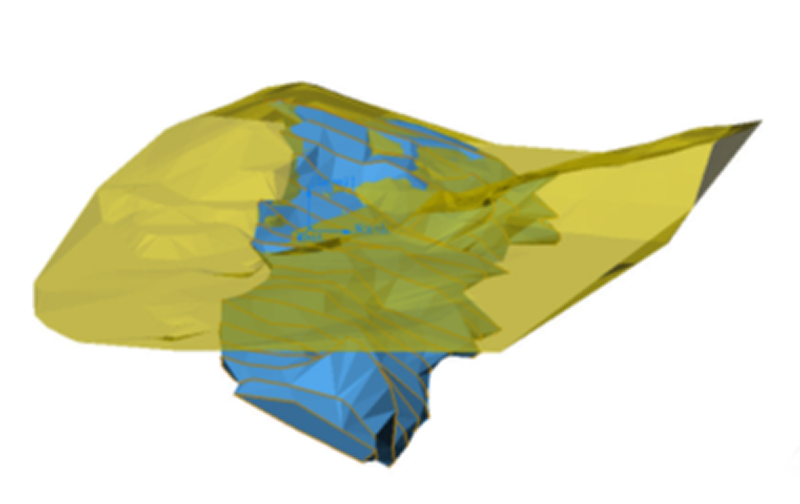Frisco management has identified and acquired the Frisco which will produce gold within a year of financing, the Granite deposit
GOLD DOME Resource
Ready-to-Mine Gold Deposit
The Gold Dome portion of the Frisco property was drilled during 1987-1990, under the supervision of professional engineers and geologists. Geological maps, drilling records, assay certificates, survey data and metallurgical test results were provided to Frisco. Assay results from 115 drill holes were used by independent professional geologist, Barbara Carroll to calculate an in-situ Indicated Resource of 23,843 troy ounces of gold in 662,310 tons and an Inferred Resource of 13,676 troy ounces of gold in 369,630 tons at a cut-off grade of 0.0123 oz Au/ton.

A resource on the higher-grade Gold Crown portion of the property, where historical underground mining was concentrated, was not calculated because of the lack of sufficient drill data. This area remains a prime exploration target.
Geology and Mineralization
The Gold Dome gold deposit occurs as a blanket-like deposit, generally conformable to the volcanic stratigraphy but severely disrupted by post-mineral faulting. The mineralized zone, which varies from a few feet to 60 feet in thickness, dips northerly at about 25 degrees on the southern exposure, flattens, and then reverses to a gentle southerly dip. The long axis of the zone of interest strikes east to northeasterly. Gold mineralization is hosted in quartz-cemented breccias of rhyolite porphyry and andesite. The gold is finely disseminated and probably occurs as micron-sized particles. Silver values are generally equivalent to gold values. Base metals are absent.
Metallurgical Testing
A pilot scale heap leach operation at Gold Dome was conducted in 1983-4. Recoveries of 60% at 1 inch and 70% at 1/2 inch during a 30-day leach cycle were characteristic of processing the 60,000. tons excavated from the Gold Dome pit.
Granite Resource
Ready-to-Mine Gold Deposit
Work on the Granite deposit began in the 1980s when Red Dog Mining drilled a series of 6-inch diameter percussion holes. Follow-up drilling by Gerle Gold in the 1987 served to further define the resource. A resource calculated in 2019 using 33 drill holes from the 1987 drilling by Gerle Gold in the Granite zone outlined a drill-indicated inferred resource of 1.6 million tons averaging 0. 02 ounces of gold per ton at a cutoff grade of 0.0123 oz Au/ton.
Although there remains more work to do to properly assess the value of the Granite deposit there are several positive factors.
This granite is softer than the more siliceous rocks found at other operations in the area. Drilling and blasting will be less expensive, crushing will be easier and less expensive. The terrain in the vicinity of the Granite deposit is less severe, meaning lower strip ratios and lower cost stripping. All of these factors would lead to lower capital and operating costs.
Geology and Mineralization
The Granite deposit occurs as a blanket like deposit, which varies from a few feet to several hundred feet in thickness, strikes generally east/west. Gold mineralization is hosted in quartz-cemented breccias of propylitically altered preCambrian granite in the lower plate of the Black Mountain Detachment Fault, which is overprinted by mineralization. The gold is finely disseminated and probably occurs as micron sized particles.
Metallurgical Testing
Metallurgical testing by McClelland Labs indicated that samples were readily amenable to direct cyanidation at a nominal 200 mesh feed size with a gold recovery of 92 percent and silver of 70 percent. Additional testing will be necessary to determine the most economic crush size for potential heap leaching.
